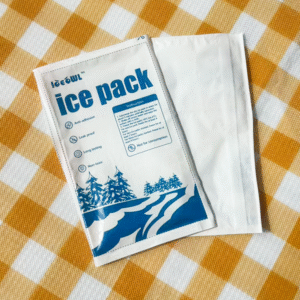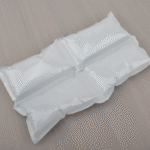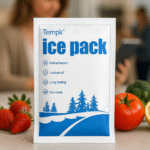Trockeneis gegen Gelpackungen: Which is the Best Cooling Solution for Cold Chain Shipping?
Choosing the right cooling solution for cold chain shipping is critical to ensuring product safety and efficiency. Trockeneis Und Gelpackungen are two common choices, each offering unique benefits. But which is better for your specific shipping needs? In diesem Artikel, we’ll explore their differences, Vorteile, and use cases to help you make an informed decision.

-
What are the key differences between dry ice and gel packs?
-
When should you choose dry ice for cold chain shipping?
-
What are the advantages of using gel packs over dry ice?
-
Which products are best suited for dry ice and gel packs?
What is the Difference Between Dry Ice and Gel Packs?
Trockeneis ist die feste Form von Kohlendioxid (Co₂), sublimating directly from a solid to a gas at extremely low temperatures of -78.5°C (-109.3° F). This property makes it ideal for long-duration shipments that need ultra-low temperatures.
Im Gegensatz, Gelpackungen are filled with a non-toxic gel substance that freezes at temperatures just below 0°C (32° F). While effective for short-term cooling, gel packs are less suitable for maintaining deep-freezing temperatures.
Schlüsselunterschiede:
| Besonderheit | Trockeneis | Gelpackungen |
|---|---|---|
| Temperaturbereich | Below -78.5°C | Above 0°C |
| Kühldauer | Bis zu 72 Std. | Bis zu 24 Std. |
| Wiederverwendbarkeit | Einweg | Wiederverwendbar |
| Moisture Issues | Keiner (sublimates to gas) | Potential moisture from melting |
When Should You Use Dry Ice?
Dry ice is perfect when deep-freezing ist erforderlich. It maintains extremely low temperatures, Es ideal für Biotech, Arzneimittel, Und Tiefkühlkost.
Best Use Cases for Dry Ice:
-
Pharmazeutika & Biotech: Impfungen, Biologische Proben, and certain medical supplies require consistent sub-zero temperatures during transit.
-
Gefrorene Lebensmittel: Dry ice ensures frozen items like meat, Meeresfrüchte, and ice cream maintain their required temperatures throughout transit.
Beispiel: A pharmaceutical company shipping life-saving vaccines will rely on dry ice to maintain the necessary frozen state for up to 72 Std..
When Should You Choose Gel Packs?
Gel packs are better suited for moderate temperature-sensitive products. While they don’t offer freezing capabilities, they are great for keeping products cool during short to medium-duration shipments.
Best Use Cases for Gel Packs:
-
Fresh Produce: Items like fruits and vegetables, which only need to remain cool and not frozen.
-
Kosmetika & Beauty Products: Many cosmetic products need to stay cool, but not frozen. Gel packs are ideal due to their versatility and ease of use.
Beispiel: A skincare brand shipping beauty products will prefer gel packs, as they only need to stay cool, nicht gefroren.
Trockeneis gegen Gelpackungen: Which is More Cost-Effective?
Während Trockeneis provides superior cooling, its cost and special handling requirements make it less affordable for certain shipments. Auf der anderen Seite, Gelpackungen are more economical and simpler to manage, Besonders für shorter shipments.
| Besonderheit | Trockeneis | Gelpackungen |
|---|---|---|
| Kosten | Higher | Lower |
| Handling Complexity | Hoch (requires gloves, Belüftung) | Niedrig (safe for general handling) |
| Kühldauer | Lang (bis zu 72 Std.) | Kurz (bis zu 24 Std.) |
How to Choose the Right Cooling Solution?
The choice between dry ice and gel packs depends on the following factors:
-
Temperaturanforderungen: If your shipment needs to stay below -18°C (0° F), dry ice is essential. For products that need to stay cool (nicht gefroren), gel packs work best.
-
Shipping Duration: Longer shipments require dry ice, while gel packs are sufficient for short-duration trips.
-
Budget: For cost-effective solutions, especially when temperatures don’t need to dip below freezing, gel packs are ideal.
-
Safety Considerations: Gel packs are easier and safer to handle, making them suitable for consumer goods.
2025 Trends in Cold Chain Shipping
Nachhaltigkeit is becoming a driving force in cold chain logistics. Gelpackungen, being reusable and more eco-friendly, are gaining popularity as businesses seek to minimize environmental impact. Zusätzlich, advancements in intelligente Verpackungen Und temperature monitoring technologies will improve cold chain efficiency.
Trends to Watch:
-
Sustainable Solutions: The rise of recyclable and biodegradable cooling methods is shaping the future of cold chain logistics.
-
Intelligente Verpackungen: RFID sensors and IoT-enabled temperature tracking will become more prevalent in ensuring the integrity of temperature-sensitive shipments.
-
Automation and AI: Automation in routing and AI-driven temperature management systems will further enhance logistics efficiency.
Häufig gestellte Fragen
Q1: How long does dry ice last compared to gel packs?
Dry ice can last up to 5 Tage, depending on the size and insulation. Gel packs typically last between 12 Zu 48 Std., depending on size and environmental conditions.
Q2: Can gel packs be reused multiple times?
Ja, gel packs are reusable and can be refrozen for multiple uses, making them an economical option.
Abschluss
Choosing the right cooling solution for your cold chain shipment depends on your specific needs. Trockeneis is perfect for long-duration, ultra-cold shipments, while Gelpackungen provide a more economical and easier-to-handle option for shorter shipments. By assessing your temperature requirements, shipping duration, and budget, you can select the best option for your goods.
Über Tempk
Bei Tempk, Wir sind spezialisiert auf die Bereitstellung tailored cold chain solutions, offering both Trockeneis Und Gelpackungen for different shipping needs. Our products ensure that your goods remain at the perfect temperature throughout the journey, minimizing risk and maximizing efficiency.
For expert advice on your cold chain shipping needs, don’t hesitate to contact us Heute!























